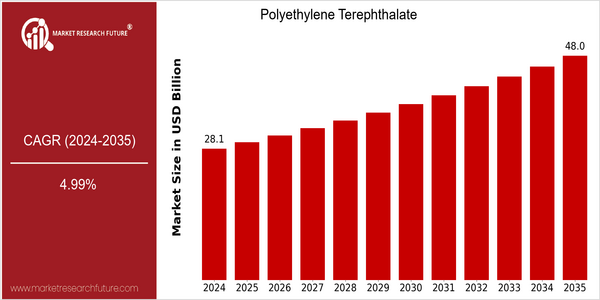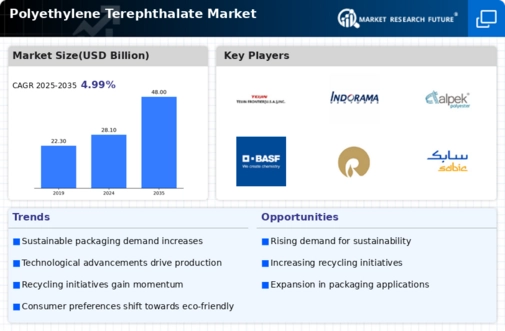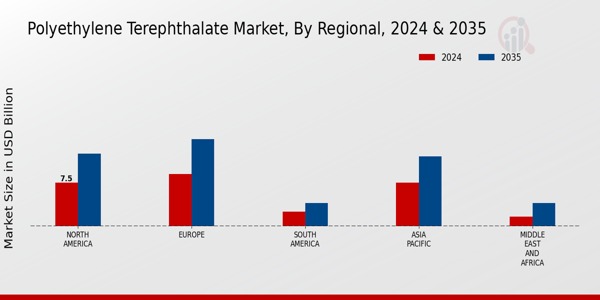-
EXECUTIVE SUMMARY
-
Market Overview
-
Key Findings
-
Market Segmentation
-
Competitive Landscape
-
Challenges and Opportunities
-
Future Outlook
-
\r\n
-
MARKET INTRODUCTION
-
Definition
-
Scope of the study
- Research Objective
- Assumption
- Limitations
-
RESEARCH METHODOLOGY
-
Overview
-
Data Mining
-
Secondary Research
-
Primary Research
- Primary Interviews and Information Gathering Process
- Breakdown of Primary Respondents
-
Forecasting Model
-
Market Size Estimation
- Bottom-Up Approach
- Top-Down Approach
-
Data Triangulation
-
Validation
-
\r\n
-
MARKET DYNAMICS
-
Overview
-
Drivers
-
Restraints
-
Opportunities
-
MARKET FACTOR ANALYSIS
-
Value chain Analysis
-
Porter's Five Forces Analysis
- Bargaining Power of Suppliers
- Bargaining Power of Buyers
- Threat of New Entrants
- Threat of Substitutes
- Intensity of Rivalry
-
COVID-19 Impact Analysis
- Market Impact Analysis
- Regional Impact
- Opportunity and Threat Analysis
-
\r\n
-
POLYETHYLENE TEREPHTHALATE MARKET, BY PROCESSING TECHNOLOGY (USD BILLION)
-
Blow Molding
-
Injection Molding
-
Extrusion
-
3D Printing
-
POLYETHYLENE TEREPHTHALATE MARKET, BY REGIONAL (USD BILLION)
-
North America
- US
- Canada
-
Europe
- Germany
- UK
- France
- Russia
- Italy
- Spain
- Rest of Europe
-
APAC
- China
- India
- Japan
- South Korea
- Malaysia
- Thailand
- Indonesia
- Rest of APAC
-
South America
- Brazil
- Mexico
- Argentina
- Rest of South America
-
MEA
- GCC Countries
- South Africa
- Rest of MEA
-
\r\n
-
COMPETITIVE LANDSCAPE
-
Overview
-
Competitive Analysis
-
Market share Analysis
-
Major Growth Strategy in the Polyethylene Terephthalate Market
-
Competitive Benchmarking
-
Leading Players in Terms of Number of Developments in the Polyethylene Terephthalate Market
-
Key developments and growth strategies
- New Product Launch/Service Deployment
- Merger & Acquisitions
- Joint Ventures
-
Major Players Financial Matrix
- Sales and Operating Income
- Major Players R&D Expenditure. 2023
-
COMPANY PROFILES
-
Teijin Limited
- Financial Overview
- Products Offered
- Key Developments
- SWOT Analysis
- Key Strategies
-
Indorama Ventures
- Financial Overview
- Products Offered
- Key Developments
- SWOT Analysis
- Key Strategies
-
LyondellBasell
- Financial Overview
- Products Offered
- Key Developments
- SWOT Analysis
- Key Strategies
-
Alpek
- Financial Overview
- Products Offered
- Key Developments
- SWOT Analysis
- Key Strategies
-
SK Chemicals
- Financial Overview
- Products Offered
- Key Developments
- SWOT Analysis
- Key Strategies
-
Perpetual Industries
- Financial Overview
- Products Offered
- Key Developments
- SWOT Analysis
- Key Strategies
-
Eastman Chemical Company
- Financial Overview
- Products Offered
- Key Developments
- SWOT Analysis
- Key Strategies
-
Theseus Capital
- Financial Overview
- Products Offered
- Key Developments
- SWOT Analysis
- Key Strategies
-
BASF
- Financial Overview
- Products Offered
- Key Developments
- SWOT Analysis
- Key Strategies
-
Reliance Industries
- Financial Overview
- Products Offered
- Key Developments
- SWOT Analysis
- Key Strategies
-
M&G Chemicals
- Financial Overview
- Products Offered
- Key Developments
- SWOT Analysis
- Key Strategies
-
Drew Marine
- Financial Overview
- Products Offered
- Key Developments
- SWOT Analysis
- Key Strategies
-
E. I. du Pont de Nemours and Company
- Financial Overview
- Products Offered
- Key Developments
- SWOT Analysis
- Key Strategies
-
SABIC
- Financial Overview
- Products Offered
- Key Developments
- SWOT Analysis
- Key Strategies
-
APPENDIX
-
References
-
Related Reports
-
LIST OF TABLES
-
\r\n
-
LIST OF ASSUMPTIONS
-
NORTH AMERICA POLYETHYLENE TEREPHTHALATE MARKET SIZE ESTIMATES & FORECAST, BY PROCESSING TECHNOLOGY, 2019-2035 (USD BILLIONS)
-
NORTH AMERICA POLYETHYLENE TEREPHTHALATE MARKET SIZE ESTIMATES & FORECAST, BY REGIONAL, 2019-2035 (USD BILLIONS)
-
US POLYETHYLENE TEREPHTHALATE MARKET SIZE ESTIMATES & FORECAST, BY PROCESSING TECHNOLOGY, 2019-2035 (USD BILLIONS)
-
US POLYETHYLENE TEREPHTHALATE MARKET SIZE ESTIMATES & FORECAST, BY REGIONAL, 2019-2035 (USD BILLIONS)
-
CANADA POLYETHYLENE TEREPHTHALATE MARKET SIZE ESTIMATES & FORECAST, BY PROCESSING TECHNOLOGY, 2019-2035 (USD BILLIONS)
-
CANADA POLYETHYLENE TEREPHTHALATE MARKET SIZE ESTIMATES & FORECAST, BY REGIONAL, 2019-2035 (USD BILLIONS)
-
EUROPE POLYETHYLENE TEREPHTHALATE MARKET SIZE ESTIMATES & FORECAST, BY PROCESSING TECHNOLOGY, 2019-2035 (USD BILLIONS)
-
EUROPE POLYETHYLENE TEREPHTHALATE MARKET SIZE ESTIMATES & FORECAST, BY REGIONAL, 2019-2035 (USD BILLIONS)
-
GERMANY POLYETHYLENE TEREPHTHALATE MARKET SIZE ESTIMATES & FORECAST, BY PROCESSING TECHNOLOGY, 2019-2035 (USD BILLIONS)
-
GERMANY POLYETHYLENE TEREPHTHALATE MARKET SIZE ESTIMATES & FORECAST, BY REGIONAL, 2019-2035 (USD BILLIONS)
-
UK POLYETHYLENE TEREPHTHALATE MARKET SIZE ESTIMATES & FORECAST, BY PROCESSING TECHNOLOGY, 2019-2035 (USD BILLIONS)
-
UK POLYETHYLENE TEREPHTHALATE MARKET SIZE ESTIMATES & FORECAST, BY REGIONAL, 2019-2035 (USD BILLIONS)
-
FRANCE POLYETHYLENE TEREPHTHALATE MARKET SIZE ESTIMATES & FORECAST, BY PROCESSING TECHNOLOGY, 2019-2035 (USD BILLIONS)
-
FRANCE POLYETHYLENE TEREPHTHALATE MARKET SIZE ESTIMATES & FORECAST, BY REGIONAL, 2019-2035 (USD BILLIONS)
-
RUSSIA POLYETHYLENE TEREPHTHALATE MARKET SIZE ESTIMATES & FORECAST, BY PROCESSING TECHNOLOGY, 2019-2035 (USD BILLIONS)
-
RUSSIA POLYETHYLENE TEREPHTHALATE MARKET SIZE ESTIMATES & FORECAST, BY REGIONAL, 2019-2035 (USD BILLIONS)
-
ITALY POLYETHYLENE TEREPHTHALATE MARKET SIZE ESTIMATES & FORECAST, BY PROCESSING TECHNOLOGY, 2019-2035 (USD BILLIONS)
-
ITALY POLYETHYLENE TEREPHTHALATE MARKET SIZE ESTIMATES & FORECAST, BY REGIONAL, 2019-2035 (USD BILLIONS)
-
SPAIN POLYETHYLENE TEREPHTHALATE MARKET SIZE ESTIMATES & FORECAST, BY PROCESSING TECHNOLOGY, 2019-2035 (USD BILLIONS)
-
SPAIN POLYETHYLENE TEREPHTHALATE MARKET SIZE ESTIMATES & FORECAST, BY REGIONAL, 2019-2035 (USD BILLIONS)
-
REST OF EUROPE POLYETHYLENE TEREPHTHALATE MARKET SIZE ESTIMATES & FORECAST, BY PROCESSING TECHNOLOGY, 2019-2035 (USD BILLIONS)
-
REST OF EUROPE POLYETHYLENE TEREPHTHALATE MARKET SIZE ESTIMATES & FORECAST, BY REGIONAL, 2019-2035 (USD BILLIONS)
-
APAC POLYETHYLENE TEREPHTHALATE MARKET SIZE ESTIMATES & FORECAST, BY PROCESSING TECHNOLOGY, 2019-2035 (USD BILLIONS)
-
APAC POLYETHYLENE TEREPHTHALATE MARKET SIZE ESTIMATES & FORECAST, BY REGIONAL, 2019-2035 (USD BILLIONS)
-
CHINA POLYETHYLENE TEREPHTHALATE MARKET SIZE ESTIMATES & FORECAST, BY PROCESSING TECHNOLOGY, 2019-2035 (USD BILLIONS)
-
CHINA POLYETHYLENE TEREPHTHALATE MARKET SIZE ESTIMATES & FORECAST, BY REGIONAL, 2019-2035 (USD BILLIONS)
-
INDIA POLYETHYLENE TEREPHTHALATE MARKET SIZE ESTIMATES & FORECAST, BY PROCESSING TECHNOLOGY, 2019-2035 (USD BILLIONS)
-
INDIA POLYETHYLENE TEREPHTHALATE MARKET SIZE ESTIMATES & FORECAST, BY REGIONAL, 2019-2035 (USD BILLIONS)
-
JAPAN POLYETHYLENE TEREPHTHALATE MARKET SIZE ESTIMATES & FORECAST, BY PROCESSING TECHNOLOGY, 2019-2035 (USD BILLIONS)
-
JAPAN POLYETHYLENE TEREPHTHALATE MARKET SIZE ESTIMATES & FORECAST, BY REGIONAL, 2019-2035 (USD BILLIONS)
-
SOUTH KOREA POLYETHYLENE TEREPHTHALATE MARKET SIZE ESTIMATES & FORECAST, BY PROCESSING TECHNOLOGY, 2019-2035 (USD BILLIONS)
-
SOUTH KOREA POLYETHYLENE TEREPHTHALATE MARKET SIZE ESTIMATES & FORECAST, BY REGIONAL, 2019-2035 (USD BILLIONS)
-
MALAYSIA POLYETHYLENE TEREPHTHALATE MARKET SIZE ESTIMATES & FORECAST, BY PROCESSING TECHNOLOGY, 2019-2035 (USD BILLIONS)
-
MALAYSIA POLYETHYLENE TEREPHTHALATE MARKET SIZE ESTIMATES & FORECAST, BY REGIONAL, 2019-2035 (USD BILLIONS)
-
THAILAND POLYETHYLENE TEREPHTHALATE MARKET SIZE ESTIMATES & FORECAST, BY PROCESSING TECHNOLOGY, 2019-2035 (USD BILLIONS)
-
THAILAND POLYETHYLENE TEREPHTHALATE MARKET SIZE ESTIMATES & FORECAST, BY REGIONAL, 2019-2035 (USD BILLIONS)
-
INDONESIA POLYETHYLENE TEREPHTHALATE MARKET SIZE ESTIMATES & FORECAST, BY PROCESSING TECHNOLOGY, 2019-2035 (USD BILLIONS)
-
INDONESIA POLYETHYLENE TEREPHTHALATE MARKET SIZE ESTIMATES & FORECAST, BY REGIONAL, 2019-2035 (USD BILLIONS)
-
REST OF APAC POLYETHYLENE TEREPHTHALATE MARKET SIZE ESTIMATES & FORECAST, BY PROCESSING TECHNOLOGY, 2019-2035 (USD BILLIONS)
-
REST OF APAC POLYETHYLENE TEREPHTHALATE MARKET SIZE ESTIMATES & FORECAST, BY REGIONAL, 2019-2035 (USD BILLIONS)
-
SOUTH AMERICA POLYETHYLENE TEREPHTHALATE MARKET SIZE ESTIMATES & FORECAST, BY PROCESSING TECHNOLOGY, 2019-2035 (USD BILLIONS)
-
SOUTH AMERICA POLYETHYLENE TEREPHTHALATE MARKET SIZE ESTIMATES & FORECAST, BY REGIONAL, 2019-2035 (USD BILLIONS)
-
BRAZIL POLYETHYLENE TEREPHTHALATE MARKET SIZE ESTIMATES & FORECAST, BY PROCESSING TECHNOLOGY, 2019-2035 (USD BILLIONS)
-
BRAZIL POLYETHYLENE TEREPHTHALATE MARKET SIZE ESTIMATES & FORECAST, BY REGIONAL, 2019-2035 (USD BILLIONS)
-
MEXICO POLYETHYLENE TEREPHTHALATE MARKET SIZE ESTIMATES & FORECAST, BY PROCESSING TECHNOLOGY, 2019-2035 (USD BILLIONS)
-
MEXICO POLYETHYLENE TEREPHTHALATE MARKET SIZE ESTIMATES & FORECAST, BY REGIONAL, 2019-2035 (USD BILLIONS)
-
ARGENTINA POLYETHYLENE TEREPHTHALATE MARKET SIZE ESTIMATES & FORECAST, BY PROCESSING TECHNOLOGY, 2019-2035 (USD BILLIONS)
-
ARGENTINA POLYETHYLENE TEREPHTHALATE MARKET SIZE ESTIMATES & FORECAST, BY REGIONAL, 2019-2035 (USD BILLIONS)
-
REST OF SOUTH AMERICA POLYETHYLENE TEREPHTHALATE MARKET SIZE ESTIMATES & FORECAST, BY PROCESSING TECHNOLOGY, 2019-2035 (USD BILLIONS)
-
REST OF SOUTH AMERICA POLYETHYLENE TEREPHTHALATE MARKET SIZE ESTIMATES & FORECAST, BY REGIONAL, 2019-2035 (USD BILLIONS)
-
MEA POLYETHYLENE TEREPHTHALATE MARKET SIZE ESTIMATES & FORECAST, BY PROCESSING TECHNOLOGY, 2019-2035 (USD BILLIONS)
-
MEA POLYETHYLENE TEREPHTHALATE MARKET SIZE ESTIMATES & FORECAST, BY REGIONAL, 2019-2035 (USD BILLIONS)
-
GCC COUNTRIES POLYETHYLENE TEREPHTHALATE MARKET SIZE ESTIMATES & FORECAST, BY PROCESSING TECHNOLOGY, 2019-2035 (USD BILLIONS)
-
GCC COUNTRIES POLYETHYLENE TEREPHTHALATE MARKET SIZE ESTIMATES & FORECAST, BY REGIONAL, 2019-2035 (USD BILLIONS)
-
SOUTH AFRICA POLYETHYLENE TEREPHTHALATE MARKET SIZE ESTIMATES & FORECAST, BY PROCESSING TECHNOLOGY, 2019-2035 (USD BILLIONS)
-
SOUTH AFRICA POLYETHYLENE TEREPHTHALATE MARKET SIZE ESTIMATES & FORECAST, BY REGIONAL, 2019-2035 (USD BILLIONS)
-
REST OF MEA POLYETHYLENE TEREPHTHALATE MARKET SIZE ESTIMATES & FORECAST, BY PROCESSING TECHNOLOGY, 2019-2035 (USD BILLIONS)
-
REST OF MEA POLYETHYLENE TEREPHTHALATE MARKET SIZE ESTIMATES & FORECAST, BY REGIONAL, 2019-2035 (USD BILLIONS)
-
PRODUCT LAUNCH/PRODUCT DEVELOPMENT/APPROVAL
-
ACQUISITION/PARTNERSHIP
-
\r\n
-
\r\n
-
\r\n
-
\r\n
-
\r\n
-
\r\n
-
\r\n
-
\r\n
-
\r\n
-
\r\n
-
\r\n
-
\r\n
-
\r\n
-
\r\n
-
\r\n
-
LIST OF FIGURES
-
\r\n
-
MARKET SYNOPSIS
-
NORTH AMERICA POLYETHYLENE TEREPHTHALATE MARKET ANALYSIS
-
US POLYETHYLENE TEREPHTHALATE MARKET ANALYSIS BY PROCESSING TECHNOLOGY
-
US POLYETHYLENE TEREPHTHALATE MARKET ANALYSIS BY REGIONAL
-
CANADA POLYETHYLENE TEREPHTHALATE MARKET ANALYSIS BY PROCESSING TECHNOLOGY
-
CANADA POLYETHYLENE TEREPHTHALATE MARKET ANALYSIS BY REGIONAL
-
EUROPE POLYETHYLENE TEREPHTHALATE MARKET ANALYSIS
-
GERMANY POLYETHYLENE TEREPHTHALATE MARKET ANALYSIS BY PROCESSING TECHNOLOGY
-
GERMANY POLYETHYLENE TEREPHTHALATE MARKET ANALYSIS BY REGIONAL
-
UK POLYETHYLENE TEREPHTHALATE MARKET ANALYSIS BY PROCESSING TECHNOLOGY
-
UK POLYETHYLENE TEREPHTHALATE MARKET ANALYSIS BY REGIONAL
-
FRANCE POLYETHYLENE TEREPHTHALATE MARKET ANALYSIS BY PROCESSING TECHNOLOGY
-
FRANCE POLYETHYLENE TEREPHTHALATE MARKET ANALYSIS BY REGIONAL
-
RUSSIA POLYETHYLENE TEREPHTHALATE MARKET ANALYSIS BY PROCESSING TECHNOLOGY
-
RUSSIA POLYETHYLENE TEREPHTHALATE MARKET ANALYSIS BY REGIONAL
-
ITALY POLYETHYLENE TEREPHTHALATE MARKET ANALYSIS BY PROCESSING TECHNOLOGY
-
ITALY POLYETHYLENE TEREPHTHALATE MARKET ANALYSIS BY REGIONAL
-
SPAIN POLYETHYLENE TEREPHTHALATE MARKET ANALYSIS BY PROCESSING TECHNOLOGY
-
SPAIN POLYETHYLENE TEREPHTHALATE MARKET ANALYSIS BY REGIONAL
-
REST OF EUROPE POLYETHYLENE TEREPHTHALATE MARKET ANALYSIS BY PROCESSING TECHNOLOGY
-
REST OF EUROPE POLYETHYLENE TEREPHTHALATE MARKET ANALYSIS BY REGIONAL
-
APAC POLYETHYLENE TEREPHTHALATE MARKET ANALYSIS
-
CHINA POLYETHYLENE TEREPHTHALATE MARKET ANALYSIS BY PROCESSING TECHNOLOGY
-
CHINA POLYETHYLENE TEREPHTHALATE MARKET ANALYSIS BY REGIONAL
-
INDIA POLYETHYLENE TEREPHTHALATE MARKET ANALYSIS BY PROCESSING TECHNOLOGY
-
INDIA POLYETHYLENE TEREPHTHALATE MARKET ANALYSIS BY REGIONAL
-
JAPAN POLYETHYLENE TEREPHTHALATE MARKET ANALYSIS BY PROCESSING TECHNOLOGY
-
JAPAN POLYETHYLENE TEREPHTHALATE MARKET ANALYSIS BY REGIONAL
-
SOUTH KOREA POLYETHYLENE TEREPHTHALATE MARKET ANALYSIS BY PROCESSING TECHNOLOGY
-
SOUTH KOREA POLYETHYLENE TEREPHTHALATE MARKET ANALYSIS BY REGIONAL
-
MALAYSIA POLYETHYLENE TEREPHTHALATE MARKET ANALYSIS BY PROCESSING TECHNOLOGY
-
MALAYSIA POLYETHYLENE TEREPHTHALATE MARKET ANALYSIS BY REGIONAL
-
THAILAND POLYETHYLENE TEREPHTHALATE MARKET ANALYSIS BY PROCESSING TECHNOLOGY
-
THAILAND POLYETHYLENE TEREPHTHALATE MARKET ANALYSIS BY REGIONAL
-
INDONESIA POLYETHYLENE TEREPHTHALATE MARKET ANALYSIS BY PROCESSING TECHNOLOGY
-
INDONESIA POLYETHYLENE TEREPHTHALATE MARKET ANALYSIS BY REGIONAL
-
REST OF APAC POLYETHYLENE TEREPHTHALATE MARKET ANALYSIS BY PROCESSING TECHNOLOGY
-
REST OF APAC POLYETHYLENE TEREPHTHALATE MARKET ANALYSIS BY REGIONAL
-
SOUTH AMERICA POLYETHYLENE TEREPHTHALATE MARKET ANALYSIS
-
BRAZIL POLYETHYLENE TEREPHTHALATE MARKET ANALYSIS BY PROCESSING TECHNOLOGY
-
BRAZIL POLYETHYLENE TEREPHTHALATE MARKET ANALYSIS BY REGIONAL
-
MEXICO POLYETHYLENE TEREPHTHALATE MARKET ANALYSIS BY PROCESSING TECHNOLOGY
-
MEXICO POLYETHYLENE TEREPHTHALATE MARKET ANALYSIS BY REGIONAL
-
ARGENTINA POLYETHYLENE TEREPHTHALATE MARKET ANALYSIS BY PROCESSING TECHNOLOGY
-
ARGENTINA POLYETHYLENE TEREPHTHALATE MARKET ANALYSIS BY REGIONAL
-
REST OF SOUTH AMERICA POLYETHYLENE TEREPHTHALATE MARKET ANALYSIS BY PROCESSING TECHNOLOGY
-
REST OF SOUTH AMERICA POLYETHYLENE TEREPHTHALATE MARKET ANALYSIS BY REGIONAL
-
MEA POLYETHYLENE TEREPHTHALATE MARKET ANALYSIS
-
GCC COUNTRIES POLYETHYLENE TEREPHTHALATE MARKET ANALYSIS BY PROCESSING TECHNOLOGY
-
GCC COUNTRIES POLYETHYLENE TEREPHTHALATE MARKET ANALYSIS BY REGIONAL
-
SOUTH AFRICA POLYETHYLENE TEREPHTHALATE MARKET ANALYSIS BY PROCESSING TECHNOLOGY
-
SOUTH AFRICA POLYETHYLENE TEREPHTHALATE MARKET ANALYSIS BY REGIONAL
-
REST OF MEA POLYETHYLENE TEREPHTHALATE MARKET ANALYSIS BY PROCESSING TECHNOLOGY
-
REST OF MEA POLYETHYLENE TEREPHTHALATE MARKET ANALYSIS BY REGIONAL
-
KEY BUYING CRITERIA OF POLYETHYLENE TEREPHTHALATE MARKET
-
RESEARCH PROCESS OF MRFR
-
DRO ANALYSIS OF POLYETHYLENE TEREPHTHALATE MARKET
-
DRIVERS IMPACT ANALYSIS: POLYETHYLENE TEREPHTHALATE MARKET
-
RESTRAINTS IMPACT ANALYSIS: POLYETHYLENE TEREPHTHALATE MARKET
-
SUPPLY / VALUE CHAIN: POLYETHYLENE TEREPHTHALATE MARKET
-
POLYETHYLENE TEREPHTHALATE MARKET, BY PROCESSING TECHNOLOGY, 2025 (% SHARE)
-
POLYETHYLENE TEREPHTHALATE MARKET, BY PROCESSING TECHNOLOGY, 2019 TO 2035 (USD Billions)
-
POLYETHYLENE TEREPHTHALATE MARKET, BY REGIONAL, 2025 (% SHARE)
-
POLYETHYLENE TEREPHTHALATE MARKET, BY REGIONAL, 2019 TO 2035 (USD Billions)
-
BENCHMARKING OF MAJOR COMPETITORS
-
\r\n












Leave a Comment